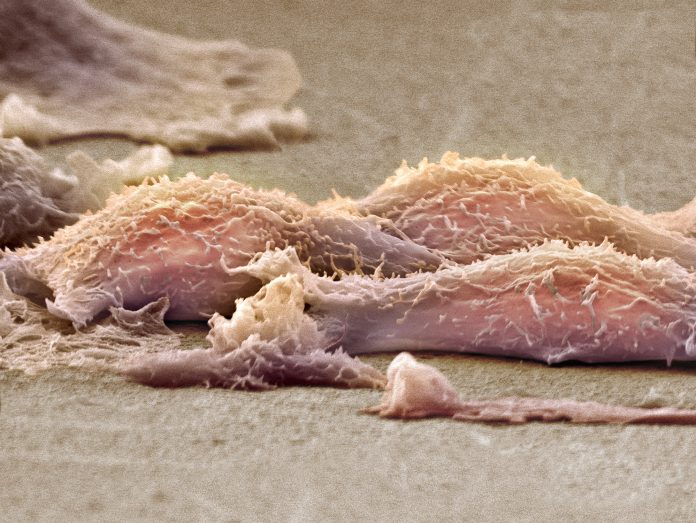
Scientists have discovered a new drug target for Ewing sarcoma, a protein known as ETV6, which is widely found in all cells, including normal cells. Known to have some function in hematopoietic cell development, its function in cancer has remained mostly unknown. Using human sarcoma cells, researchers from the Cold Spring Harbor Laboratory (CSHL) discovered that inhibiting ETV6 stopped the cancer from growing, presenting a possible new target for new therapies for Ewing sarcoma. Their results are published in a paper in Nature Cell Biology.
The authors used CRISPR library screens to first identify genetic dependencies that are unique to Ewing sarcoma cells, uncovering the transcription factor protein ETV6. “This is the first time showing that ETV6 has a role in Ewing sarcoma,” said first author Yuan Gao, a postdoctoral fellow in the CSHL laboratory of Christopher Vakoc. The protein does not appear to have a significant role in normal, healthy cells but in the presence of sarcoma it becomes deadly.
Ewing sarcoma is driven by an oncofusion called the EWS-FLI1, a discovery made decades ago. The presence of this oncofusion triggers the expression of the ETV6 protein which is then found in large abundance. “Only in the cancer context does ETV6 activity lead to cancer growth by helping cancer cells repress differentiation,” aded Gao.
In their experiments in human Ewing sarcoma cells, Vakoc and Gao disrupted the activity of the protein to see its effects. Through knock-out genomic studies, they observed that deleting the gene protein entirely in cancer cells interfered with cancer growth. In a second series of studies, they tested a ‘dominant negative’ perturbed fragment of the ETV6 protein—a small part of the protein that binds normally but with inhibited activity. Again, cancer growth was minimized. This mechanism demonstrates how inactivating ETV6 converts EWS-FLI1 from an oncoprotein into a tumor suppressor by reprogramming it towards differentiation-promoting genes.
“The sarcoma cell reverts back into being a normal cell again,” Gao said. “The shape of the cell changes. The behavior of the cells changes. A lot of the cells will arrest their growth. It’s really an explosive effect.” Other good news found in their studies includes the fact that most healthy cells were unaffected by the loss of ETV6 activity.
This research discovery suggests researchers may be able to inhibit Ewing sarcoma by developing treatments that block ETV6.
There is no targeted therapy available for Ewing sarcoma, a disease whose diagnosis is based on the presence of the EWS-FLI1 oncofusion. “This fusion, discovered 30-40 years ago, is the best target but direct targeting it historically has been proven to be very,” noted Gao. “Now with ETV6 we have identified another one that is specific to Ewing sarcoma raising its possibility as a new drug target.”
Moving forward, the team plans on learning more about how ETV6 supports Ewing sarcoma. The team has already been able to identify unique areas of the protein that they see are essential to its function in cancer cells. Said Gao: “In the future, we want to be able to modulate ETV6’s function to facilitate future targeting strategies.”













